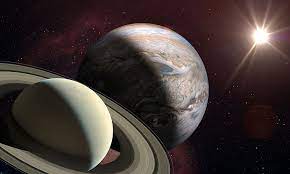Jupiter
Jupiter, the largest planet in our solar system, commands attention with its immense size and captivating presence. Named after the king of the Roman gods, Jupiter stands as a majestic giant, dominating the realms of space with its colossal mass. Located fifth from the Sun, this gas giant boasts a diameter more than 11 times that of Earth, making it larger than all the other planets combined. Its vibrant bands of clouds, swirling storms, and iconic Great Red Spot create a mesmerizing spectacle that captivates both astronomers and casual observers alike. With its numerous moons, intricate ring system, and powerful magnetic field, Jupiter embodies the complexity and grandeur of our cosmic neighborhood.


Introduction to jupiter
Jupiter, the largest planet in our solar system, commands attention with its immense size and captivating presence. Named after the king of the Roman gods, Jupiter stands as a majestic giant, dominating the realms of space with its colossal mass. Located fifth from the Sun, this gas giant boasts a diameter more than 11 times that of Earth, making it larger than all the other planets combined. Its vibrant bands of clouds, swirling storms, and iconic Great Red Spot create a mesmerizing spectacle that captivates both astronomers and casual observers alike. With its numerous moons, intricate ring system, and powerful magnetic field, Jupiter embodies the complexity and grandeur of our cosmic neighborhood. Its study not only reveals the secrets of this magnificent planet but also offers insights into the formation and dynamics of planetary systems, providing a gateway to understanding the vast universe beyond..

The exploration of Jupiter
The exploration of Jupiter has been a remarkable endeavor that has expanded our knowledge and deepened our fascination with this colossal planet. NASA's Pioneer and Voyager missions provided the first close-up glimpses of Jupiter in the 1970s and 1980s, revealing its intricate cloud patterns, massive storms, and the enigmatic Great Red Spot. These missions paved the way for further exploration, leading to the arrival of the Galileo spacecraft in 1995. Galileo provided detailed observations of Jupiter's atmosphere, its powerful magnetic field, and its intriguing moons, including the discovery of potential subsurface oceans on some of them. In 2016, NASA's Juno mission reached Jupiter, embarking on an ambitious mission to study the planet's atmosphere, magnetic field, and inner structure. Juno's close flybys have allowed scientists to unravel the mysteries of Jupiter's powerful storms, like the cyclones at its poles, and gain insight into its complex magnetic field..

Jupiter's Role in the Solar System
Jupiter plays a crucial role in the dynamics and balance of our solar system. Its immense size and gravitational influence shape the structure and behavior of nearby celestial bodies. Acting as a cosmic vacuum cleaner, Jupiter's powerful gravity has a significant impact on the distribution and dynamics of asteroids, comets, and other debris in the solar system. Its gravitational pull can either capture these objects, divert their paths, or eject them from the system entirely, helping to maintain the stability of the inner planets. Moreover, Jupiter's atmosphere and magnetosphere provide unique insights into the study of planetary atmospheres and space weather. Its swirling cloud bands, turbulent storms, and the iconic Great Red Spot offer a natural laboratory for understanding atmospheric dynamics on a grand scale. Jupiter's intense magnetic field, one of the strongest in the solar system, generates powerful radiation belts and auroras, enabling scientists to investigate the processes of magnetospheric interactions and better understand similar phenomena occurring on Earth and other planets.